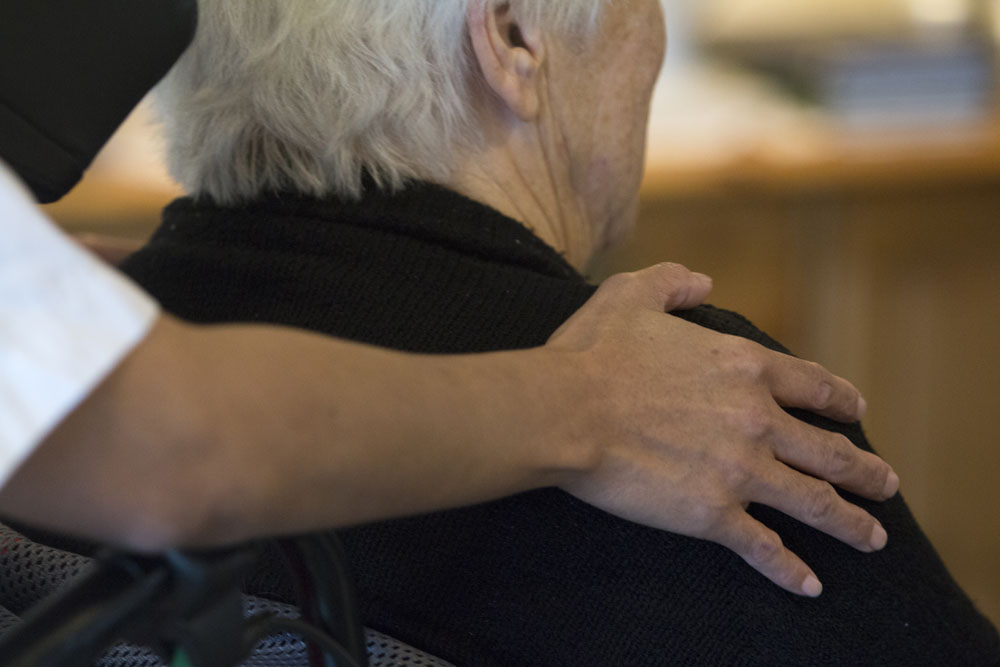Have you had any situation where someone becomes threatening or very anxious at your elderly home?
This article is written from a Swedish perspective, but hopefully it can be an inspiration for those interested from other countries.
Sometimes people with dementia change in their mentality. In the worst case, it can lead to threatening situations. Nursing homes should have safe routines to deal with people who become anxious, angry and sometimes threatening. Staff may need to train in how to deal with a person who is threatening in order to reduce the risk of violence and someone getting hurt.
 Foto: Mostphotos
Foto: MostphotosIf a resident becomes threatening
It happens that people in nursing homes become depressed and no longer want to live. Sometimes, older people also develop paranoid delusions or feel that the staff wants to poison them or harm them in some other way. It can also happen that a resident is irritated by one of the other people living in the unit.
Action plan when someone is threatening
When the staff at a nursing home are confronted with a situation where a resident becomes threatening, it is important to act calmly, professionally, and with respect for both the resident and other residents' safety and well-being.
Maintain calm: It is important that the staff remains calm and maintains control over the situation. Keeping a calm and safe demeanor can help calm the resident down and reduce the risk of the threat escalating. Respond calmly and kindly with short answers. Those in a state of affect have difficulty absorbing complicated messages. Maintain a respectful tone, avoid being condescending or threatening in words or body language. Allow the person to express their feelings and frustrations. Actively listen to what they are saying and show understanding.
Create distance: If the situation involves a physical threat, it is important that the staff creates distance and avoids getting into direct confrontation with the resident. This may involve gently stepping back and avoiding blocking escape routes. Try to understand what is causing the irritation.
Secure the area: You also have a responsibility to try to protect other residents who may be at risk of violence. If the situation requires it, ensure that other residents and staff are safe by carefully moving them to another location if possible. Contact the responsible nurse and possibly the police if the situation requires it.
Document the incident: After the situation has calmed down, it is important to document the incident carefully. This can include a description of what happened, any actions taken, and the outcome of the situation.
Follow up - conduct event analysis: After an incident of threatening behavior, it is important to follow up with the resident to try to understand the causes of the behavior and work to prevent future incidents. It may also be wise to evaluate the nursing home's routines and resources for handling similar situations in the future. An event analysis can contribute to developing routines for new situations. If someone has been injured or risked being injured, an occupational injury report and deviation on the incident should also be written.
By having clear guidelines for handling threatening situations, and by offering relevant training and support to the staff, the nursing home can work to create a safe and secure environment for both residents and staff. The person may appear to be suffering from dementia, but in reality may have a depression that leads to confusion. It has happened that older people have jumped from the balcony of nursing homes. If someone is severely suffering from a serious mental disorder and has an "indispensable" need for psychiatric care and also opposes admission, a doctor can write a care certificate. Indispensable means that there are no other alternatives. Sometimes the person may become threatening to the staff or want to harm themselves or another resident.
Usually, it is the resident's doctor or the on-call emergency service who writes the care certificate. The decision for compulsory care is then taken by a psychiatrist. There should always be an assessment by two doctors, one of whom must be a psychiatrist. People with dementia are very rarely considered to meet the criteria for compulsory care. It is then more often about increasing staffing and providing more guidance to colleagues so that they can provide support in the best way.
What care the person must have should, when assessing, be done in relation to the possibility of other interventions in the nursing home. Then the operation needs to go through what support the elderly are in need of, what support they get in the accommodation and how the support can be improved. It may be about increased staffing, activities, changed medication and other measures that can be taken at the unit. By having a person living in a nursing home already has a safe environment with staff around the clock, the criteria for psychiatric compulsory care very rarely hold.
Guidance by BPSD (behavioural and psychological symptoms in dementia) team can also be an effort to increase understanding of what makes the elderly anxious or angry. A BPSD team are specialists in understanding and finding approaches to Behavioral and Psychological Symptoms in Dementia. That the staff group finds a safe way to relate to a worried, irritated or scared resident usually calms down the situation in itself. Sometimes it may be necessary to increase staffing.
In threatening situations, the best approach is to first and foremost maintain calm and avoid escalating the situation. Acting with empathy, respect, and understanding towards the person exhibiting threatening behavior can help reduce tension and increase the chances of a positive outcome. Below are some principles for good treatment in threatening situations:
If the staff is trained in low-impact treatment, they have better conditions to meet a person who is worried, angry, and perhaps threatening. This can prevent the situation from worsening or someone being harmed. If they are recurring events, successful strategies can be documented in a response plan.
Reflection questions - threatening situations
Care staff:
- How do you work with people who are desperate, terrified, or perhaps express suicidal thoughts?
- Have you received case management at any time? Is there a functioning routine for threat and violence situations in the unit?
Manager, nurse, occupational therapist, and physiotherapist:
- Do you have good routines for handling threats and violence?
- Are they known by all employees?
- Are there routines for how you handle a resident who expresses suicidal thoughts?
- Are there routines for how you handle the need for a care certificate assessment?
Resident and relative:
- Do you have a relative who talks about committing suicide or becomes angry and threatening?
- Have you been able to participate and reason about how such situations are best managed in the accommodation?
Erland Olsson
Specialist Nurse
Sofrosyne
Better care every day

Aktuellt i media
- 2025-12-03 04:00 06 Dokumentation
- 2025-12-01 04:00 02 Värdegrund
- 2025-11-27 04:00 13 Hygien
-
2025-11-24 04:00
03 Ledarskap
Leadership and Development - Future Elderly Homes, Development Work for Better Care
info Foto: Mostphotos
Foto: Mostphotos - 2025-11-20 04:00 15 Handlingsberedskap
- 2025-11-17 04:00 16 Sjukdom och död






